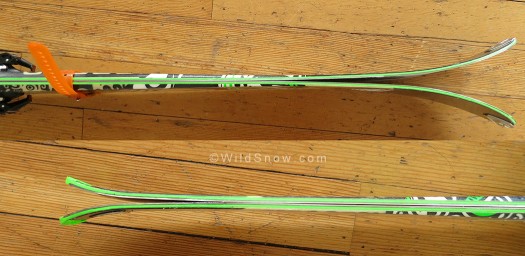I debated long and hard on what to bring on my recent backcountry ski trip out of Haines, Alaska. One of the harder choices was skis. I knew (or hoped) that all we were likely to find was deep powder. However, I also knew that it was full-on ski mountaineering with steep climbs, descents, and long days. I didn’t think my fat fun powder ski would be quite right, but I also wanted a ski that would be exciting for big lines, fast.
Ultimately I decided to bring two pairs. One was my 188 K2 Darksides, a ski I’ve had for about 2 years. K2s run long, so they are more like 193, and with substantial rocker, a stiff tail, and 130mm underfoot, they are incredibly fun. I knew they covered the fast, fun side of skis, but they are heavy. So I wanted a pair of fat, light skis for longer days. I didn’t have a pair of planks that really fit the bill, so I scored some 188 Dynafit Huascarans to try out.
Huascarans are Dynafit’s widest ski, at 135 / 114 / 124 mm. They weigh in at about 65 ounces per ski (1843 grams), making them light for their size (see stats below). They have a rockered tip, and a tiny bit of rocker in the tail, with camber underfoot. The ski has cap construction, with small sidewalls located just above the edges, ostensibly to add edging power.
I picked up the Huascarans right before I left and didn’t have a chance to test, something I was a little hesitant about. I took them anyways and gave them a first run on the powdery peaks of Alaska. Now there’s some ski testing for ya! While most of the snow encountered on the trip was pow, I did manage to find a bit of harder snow. Given the Huascaran’s light weight, I expected them to have compromised performance on the down. However, they surprised me. They ripped through pow, and though I wouldn’t call them a piste ski they performed very well on hard snow.
The light weight of the Huascarans was awesome, especially combined with their downhill performance. I ended up using them the majority of the days of the trip. Although they had a slightly lower speed limit than my other skis, they still were able to handle the big Alaskan faces. Of course, given their light weight, there is a little bit of compromise. Mainly, at speed they don’t ski quite as well as some heavier skis out there, especially on difficult snow (full disclosure, yes, Alaskan pow isn’t always perfect).
Throughout the trip I also used the Dynafit pre-cut Speed skins on the Huascarans. Dynafit skins are super light and packable, making a light setup even lighter. However, I’ve never been much of a fan of Dynafit’s skin attachment system. The stretchy tip attachment tends to stretch and come undone, mostly in difficult snow conditions.
According to our weight charts, the 167 cm Huscaran we have at WildSnow HQ scores 81 for weight/surface, which is below our current 82.5 average. In terms of weight/length, we get a score of 9.44, just above our current average of 9.04. Since this is a wider ski that means it’s quite light in weight. Overall weight of the 167 is 1,576 grams (55.6 oz). Longer skis will of course be heavier overall, but will retain similar though sometimes slightly heavier ratios.
I’ve never been a huge fan of Dynafit skis, instead preferring styles that are designed for a higher speed, less turny style. However, the Huascarans proved to be a super light pow ski that holds up will in a variety of snow conditions and supported the kind of skiing I like to do. They now have an honored position in my quiver.
Get a pair of Dynafit skis here.
Louie Dawson earned his Bachelor Degree in Industrial Design from Western Washington University in 2014. When he’s not skiing Mount Baker or somewhere equally as snowy, he’s thinking about new products to make ski mountaineering more fun and safe.


